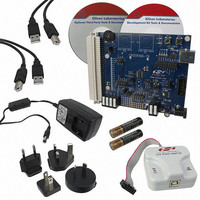C8051F996DK Silicon Laboratories Inc, C8051F996DK Datasheet - Page 214

C8051F996DK
Manufacturer Part Number
C8051F996DK
Description
KIT DEV FOR C8051F996
Manufacturer
Silicon Laboratories Inc
Type
MCUr
Datasheets
1.C8051F996DK.pdf
(24 pages)
2.C8051F996DK.pdf
(2 pages)
3.C8051F996DK.pdf
(4 pages)
4.C8051F996DK.pdf
(322 pages)
Specifications of C8051F996DK
Contents
Board, Batteries, Cables, CDs, Debug Adapter, Documentation, Power Adapter
Processor To Be Evaluated
C8051F996
Processor Series
C8051F98x
Interface Type
USB
Operating Supply Voltage
3 V
Lead Free Status / RoHS Status
Lead free / RoHS Compliant
For Use With/related Products
C8051F996
Lead Free Status / Rohs Status
Lead free / RoHS Compliant
Other names
336-1963
- C8051F996DK PDF datasheet
- C8051F996DK PDF datasheet #2
- C8051F996DK PDF datasheet #3
- C8051F996DK PDF datasheet #4
- Current page: 214 of 322
- Download datasheet (3Mb)
C8051F99x-C8051F98x
21.1. Port I/O Modes of Operation
Port pins P0.0–P1.7 use the Port I/O cell shown in Figure 21.2. Each Port I/O cell can be configured by
software for analog I/O or digital I/O using the PnMDIN registers. On reset, all Port I/O cells default to a dig-
ital high impedance state with weak pull-ups enabled.
21.1.1. Port Pins Configured for Analog I/O
Any pins to be used as Comparator or ADC input, oscillator input/output, or AGND, VREF, or Current Ref-
erence output should be configured for analog I/O (PnMDIN.n = 0). When a pin is configured for analog
I/O, its weak pullup and digital receiver are disabled. In most cases, software should also disable the digital
output drivers. Port pins configured for analog I/O will always read back a value of 0 regardless of the
actual voltage on the pin.
Configuring pins as analog I/O saves power and isolates the Port pin from digital interference. Port pins
configured as digital inputs may still be used by analog peripherals; however, this practice is not recom-
mended and may result in measurement errors.
21.1.2. Port Pins Configured For Digital I/O
Any pins to be used by digital peripherals (UART, SPI, SMBus, etc.), external digital event capture func-
tions, or as GPIO should be configured as digital I/O (PnMDIN.n = 1). For digital I/O pins, one of two output
modes (push-pull or open-drain) must be selected using the PnMDOUT registers.
Push-pull outputs (PnMDOUT.n = 1) drive the Port pad to the VDD or GND supply rails based on the out-
put logic value of the Port pin. Open-drain outputs have the high side driver disabled; therefore, they only
drive the Port pad to GND when the output logic value is 0 and become high impedance inputs (both high
and low drivers turned off) when the output logic value is 1.
When a digital I/O cell is placed in the high impedance state, a weak pull-up transistor pulls the Port pad to
the VDD supply voltage to ensure the digital input is at a defined logic state. Weak pull-ups are disabled
when the I/O cell is driven to GND to minimize power consumption and may be globally disabled by setting
WEAKPUD to 1. The user must ensure that digital I/O are always internally or externally pulled or driven to
a valid logic state. Port pins configured for digital I/O always read back the logic state of the Port pad,
regardless of the output logic value of the Port pin.
214
WEAKPUD
(Weak Pull-Up Disable)
Pn.x – Output
Logic Value
(Port Latch or
Crossbar)
PnMDOUT.x
(1 for push-pull)
(0 for open-drain)
XBARE
(Crossbar
Enable)
Pn.x – Input Logic Value
(Reads 0 when pin is configured as an analog I/O)
To/From Analog
Peripheral
PnMDIN.x
(1 for digital)
(0 for analog)
Figure 21.2. Port I/O Cell Block Diagram
Rev. 1.0
VDD/DC+
GND
VDD/DC+
(WEAK)
PORT
PAD
Related parts for C8051F996DK
Image
Part Number
Description
Manufacturer
Datasheet
Request
R
Part Number:
Description:
SMD/C°/SINGLE-ENDED OUTPUT SILICON OSCILLATOR
Manufacturer:
Silicon Laboratories Inc
Part Number:
Description:
Manufacturer:
Silicon Laboratories Inc
Datasheet:
Part Number:
Description:
N/A N/A/SI4010 AES KEYFOB DEMO WITH LCD RX
Manufacturer:
Silicon Laboratories Inc
Datasheet:
Part Number:
Description:
N/A N/A/SI4010 SIMPLIFIED KEY FOB DEMO WITH LED RX
Manufacturer:
Silicon Laboratories Inc
Datasheet:
Part Number:
Description:
N/A/-40 TO 85 OC/EZLINK MODULE; F930/4432 HIGH BAND (REV E/B1)
Manufacturer:
Silicon Laboratories Inc
Part Number:
Description:
EZLink Module; F930/4432 Low Band (rev e/B1)
Manufacturer:
Silicon Laboratories Inc
Part Number:
Description:
I°/4460 10 DBM RADIO TEST CARD 434 MHZ
Manufacturer:
Silicon Laboratories Inc
Part Number:
Description:
I°/4461 14 DBM RADIO TEST CARD 868 MHZ
Manufacturer:
Silicon Laboratories Inc
Part Number:
Description:
I°/4463 20 DBM RFSWITCH RADIO TEST CARD 460 MHZ
Manufacturer:
Silicon Laboratories Inc
Part Number:
Description:
I°/4463 20 DBM RADIO TEST CARD 868 MHZ
Manufacturer:
Silicon Laboratories Inc
Part Number:
Description:
I°/4463 27 DBM RADIO TEST CARD 868 MHZ
Manufacturer:
Silicon Laboratories Inc
Part Number:
Description:
I°/4463 SKYWORKS 30 DBM RADIO TEST CARD 915 MHZ
Manufacturer:
Silicon Laboratories Inc
Part Number:
Description:
N/A N/A/-40 TO 85 OC/4463 RFMD 30 DBM RADIO TEST CARD 915 MHZ
Manufacturer:
Silicon Laboratories Inc
Part Number:
Description:
I°/4463 20 DBM RADIO TEST CARD 169 MHZ
Manufacturer:
Silicon Laboratories Inc










